Handball drills for technique throw
This can make use of an existing outline of a badminton field's lines, or be created with cones.
This serves 3 purposes:
This serves 3 purposes:
- Passing
- Moving to receive the ball
- Defense
- You will need 3 pairs of players.
- Two pairs on opposite ends of the delimited area trying to pass the ball to each other, and one pair in the middle intercepting.
- The pairs on each end, can not pass to their partner, they have to pass to the other pair at the other side of the court.
- They can not pass the centre point.
- The defending pair will either try to touch the person with the ball, or to intercept the pass.
- Once the defending team succeeds in one of these, then they swap.
- If the pass is out of bounds, they also swap.

This is a resistance and mental strength exercise.
- Each player goes to their position. They will have to take 3 - 5 shots in a row, running back to the position as soon as they shoot. For every two shots, they will have to change the third shot.
- The objective, more than building resistance, is to build mental strength to make the body go forward when we're tired.
- This will be repeated several times.
- The first couple of times the players won't be tired, but after the third or fourth repetition of the series of shots in a row, then they will.
- There can also be one player (pivot for example) blocking shots (not 100% defense, just 30%)
- If the overall team scores more than 50% than the keeper does 20 push ups, 20 sit ups, and 20 squats.
- If the team scores less than, then the team does it.
- Make 6 or 8 columns of players (at least 2 in each column).
- They will have 2 balls in play, with some time distance. (wait until the first ball reaches the middle point and then the second ball starts being passed around)
- The players will have to pass the ball and run to the column they just passed the ball to.
- They will have to be running when they pass the ball, and change passes after a while (normal, bounce, side, underarm,...)
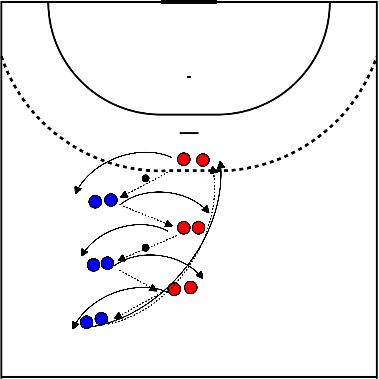
2 and 2 and 3 balls per group
- Start with 3 balls per group. 1 ball on the ground and played back and forth with the feet, while the other 2 are passed back and forth. Never hold the balls in hands for more than 1 second, always pass back immediately. Don't be nice to your partner, challenge them.
- Then have 2 balls, with 1 player holding the ball in hand. Throw the ball up and while it's in the air, pass the other ball back and forth once. Make it harder by trying to pass 2, then 3, then 4, then 5 times while the ball is in the air.
- 2 balls per group - 1 player starts with both balls. Throw 1 high ball and during that time, quickly pass the other ball. The second ball should be caught before the high ball is caught. Add the challenge of passing the quick ball back.
- 3 balls per group - 1 player starts with all the balls. Throw them in an arc, one by one. All 3 balls should be in the air at the same time and then caught by the receiver.
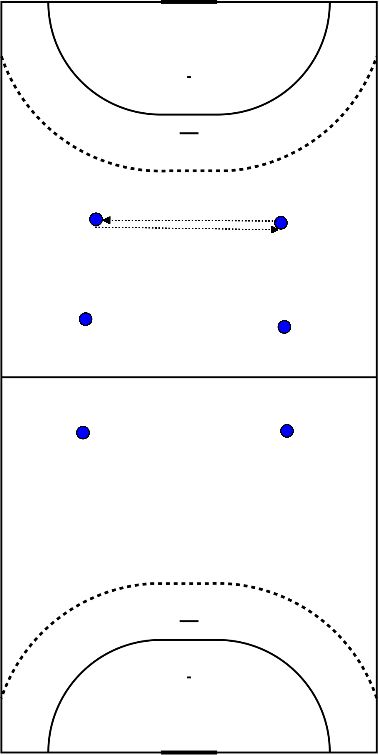
Materials:
- use 2-3 soft balls (f-youth foam ball)
Explanation:
- Set out a field adapted to the number of players.
- If you have a ball try to throw others off.
- If you are hit you stand in the goal.
- If someone catches the ball then everyone is free again.
- Last one remaining wins
Variation:
- do not dribble
- don't run
- throw with the wrong arm
The players form a line at one end of the court.
- The 2nd player on the line passes the ball to the coach who will be between the centre of the court and the 12 meters.
- The 1st player on the line runs as soon as the pass is made.
- The coach will then pass the ball to the front of the 1st player who is running towards the opposite goal to receive the ball.
- The pass will not be towards the player's hands, but rather to a step in front of where they are, so they continue accelerating.
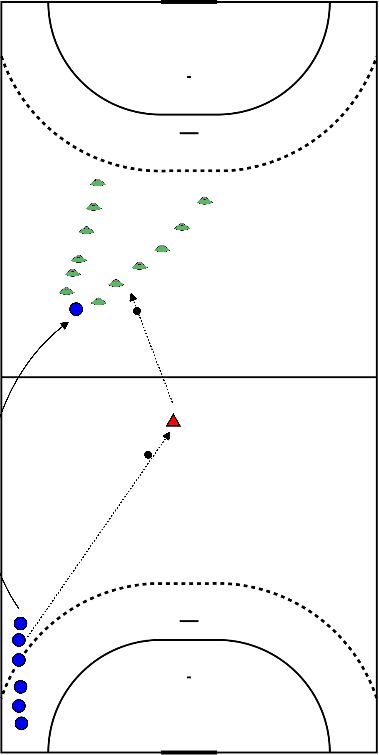
This can be done in groups of 2 or 3 players.
- This is to get used to receiving the ball in motion, facing the goal.
- This is a passing exercise as well.
- Let's take a group of 3 players.
- There will be two cones on the floor, at around 10 meters, on each side of the centre back, and 2 cones at the 7 meters in front of the half backs.
- The centre back has the ball, and for the half back to receive the ball, they need to start behind the cone of the 10 meters, and run in front of it.
- The centre back can only pass the ball in the direction after the cone. Once the half back receives the ball, they will do two/three steps towards the 7 meter cone, stop, and pass the ball back to the centre half who must start before the 10 meter cone and receive the ball after it.
- The half back then returns to their spot and the centre back continues the exercise with the other side half back.
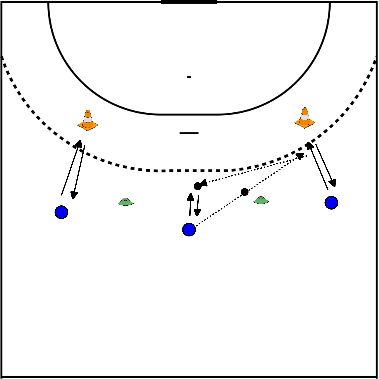
This can be done with groups of 3 to 7 - odd numbers ideally.
- Let's assume a group of 5 players.
- We'll have 3 attackers and 2 defenders.
- The 3 attackers will have a delimited running corridor in a straight line and they will have to pass the ball from one to the others while the 2 defenders will have to try and intercept the passes. The defenders have freedom of movement.
- The exercise can evolve in the types of passes in order to foster movement without the ball.
- First all types of pass, then no lob passes, then only bounce passes.
If the defenders intercept the pass, they continue the exercise acting as the attacking players in numerical inferiority. The 3 attacking players now have no restriction of movement.
This is to be done slowly at first, not as a fast break, to instill the idea of moving without the ball first. The speed can be adapted as the exercise goes on.
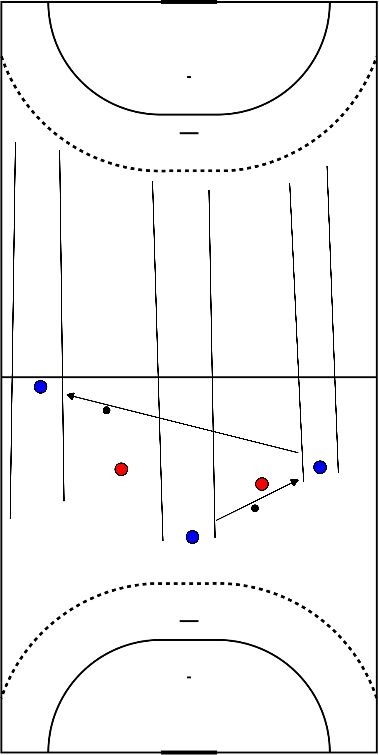
- 2 rows of players at 11 meters
- dribble and jump on run shot
- hands
- left/right high
- left/right low
- ground
Keeper indicates himself takes charge of this exercise
Duo opposite each other with 1 ball
- Distance 3 meters over throw (pay attention to elbow above shoulder, correct leg and pass on throwing arm)
- In motion (move forward on approach, backward, receive ball and move forward again)
- Increasing distance with bounce (note in hands, bounce just over center)
- Jump shot
- Passing sideways
- Pass too low and catch!
- Pass to high and catch!
- Flyer
- Increase distance
- 2 balls at the same time
- 1 rolls the ball, the other throws
- divide players among the pawns
- player 1 runs straight ahead but plays the ball off to the right collapsing player 2
- player 2 also runs straight ahead and plays the ball off to the right
- make it more difficult by playing 2 balls at the same time (start opposite each other)
- change direction during the exercise
- pass with a bounce
pay attention to timing start/finish

- Tjoek throwing - short arm.
- Rounding goal. Pawn in goal.
- Sprint back - turn off where to run past.
- Bench upside down - keep balance until it's your turn again
Attention on throwing with short arm and rounding stretch throw.









